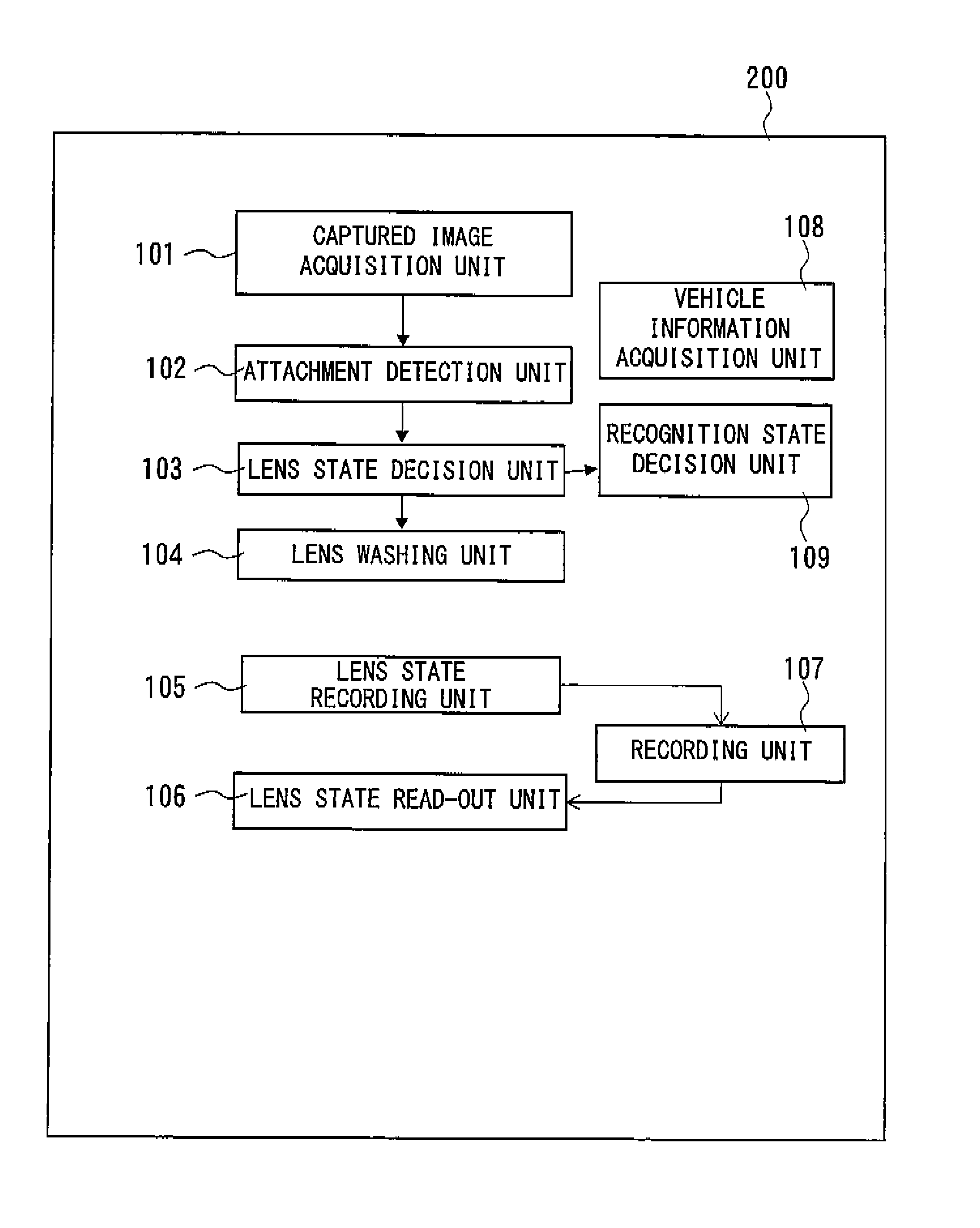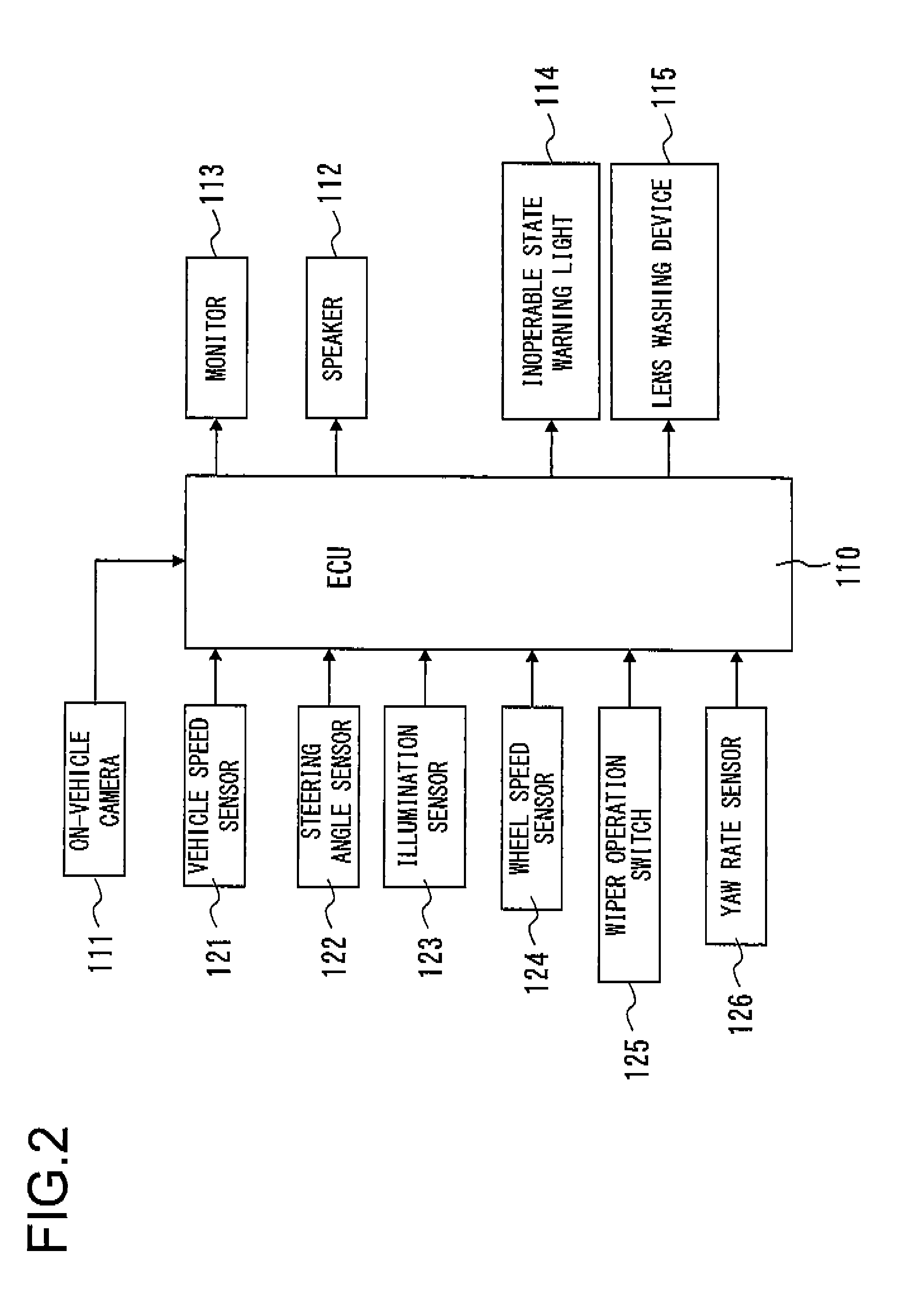Vehicle surroundings monitoring device
a monitoring device and vehicle technology, applied in the field of vehicle surroundings monitoring devices, can solve the problems of becoming impossible to accurately detect a photographic object such as a preceding vehicle, and contaminants tend to adhere to the front surface of the lens, so as to prevent useless washing
- Summary
- Abstract
- Description
- Claims
- Application Information
AI Technical Summary
Benefits of technology
Problems solved by technology
Method used
Image
Examples
first embodiment
[0026](First Embodiment)
[0027]According to the first embodiment of the present invention, first, upon starting an engine, the type, amount and site of attachments (foreign matter, contaminants (or dirt)) (hereafter, referred to as “attachments information”) recorded at the time when the engine was lastly stopped is read in. Next, during running within a predetermined time from the start of the engine (hereafter, referred to as “within an initial diagnosis time”), the surroundings of the vehicle is monitored with an on-vehicle (in-vehicle) camera in order to decide whether attachments such as rain drops, mud, white turbidity (cloudiness matter), water drop marks, fallen leaves, and so on are attached. If the amount of attachments has increased as compared with the amount of attachments recorded by a predetermined amount or more, a washing device is operated. Then, the attachments information is recorded at the time when the engine is stopped.
[0028]FIG. 1 presents a diagram illustrati...
second embodiment
[0092](Second Embodiment)
[0093]A second embodiment according to the present invention is explained. According to the second embodiment of the present invention, first at the time of starting the engine, an inoperable state in addition to the attachments information recorded at the time of the previous stoppage of the engine is read in. Next, during traveling within a predetermined time after the start of the engine (hereafter, referred to “within an initial diagnosis time”), the surroundings of the vehicle is monitored with an on-vehicle camera to decide attachment of rain droplets, mud, white turbidity, water droplet marks, foreign matter such as fallen leaves and so on. If the amount of attachments increased as compared with the recorded amount of attachments by a predetermined amount or more, the washing device is operated. Then, at the time when the engine is stopped, the attachments information and the inoperable state are recorded.
[0094]That is, the second embodiment is diffe...
third embodiment
[0117](Third Embodiment)
[0118]A third embodiment of the present invention is explained. In the third embodiment, first, the attachments information recorded at the time of the last stoppage of the engine is read in at the time when the engine is started. Next, during traveling within a predetermined period of time after the start of the engine (hereafter, referred to as “within an initial diagnosis time”), the surroundings of the vehicle is monitored with an on-vehicle camera to decide situations in which surrounding light source environment is different such as day and night and decide attachment of foreign matter such as rain drops, mud, white turbidity, water droplet marks, foreign matter such as fallen leaves and so on depending on the surrounding light source environment. If the amount of the attachments increases by a predetermined amount or more as compared to the amount of the attachments recorded, the washing device is operated. Then, at the time the engine is stopped, the...
PUM
 Login to View More
Login to View More Abstract
Description
Claims
Application Information
 Login to View More
Login to View More - R&D
- Intellectual Property
- Life Sciences
- Materials
- Tech Scout
- Unparalleled Data Quality
- Higher Quality Content
- 60% Fewer Hallucinations
Browse by: Latest US Patents, China's latest patents, Technical Efficacy Thesaurus, Application Domain, Technology Topic, Popular Technical Reports.
© 2025 PatSnap. All rights reserved.Legal|Privacy policy|Modern Slavery Act Transparency Statement|Sitemap|About US| Contact US: help@patsnap.com



